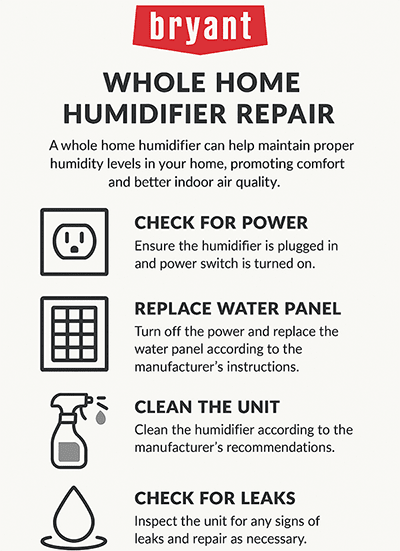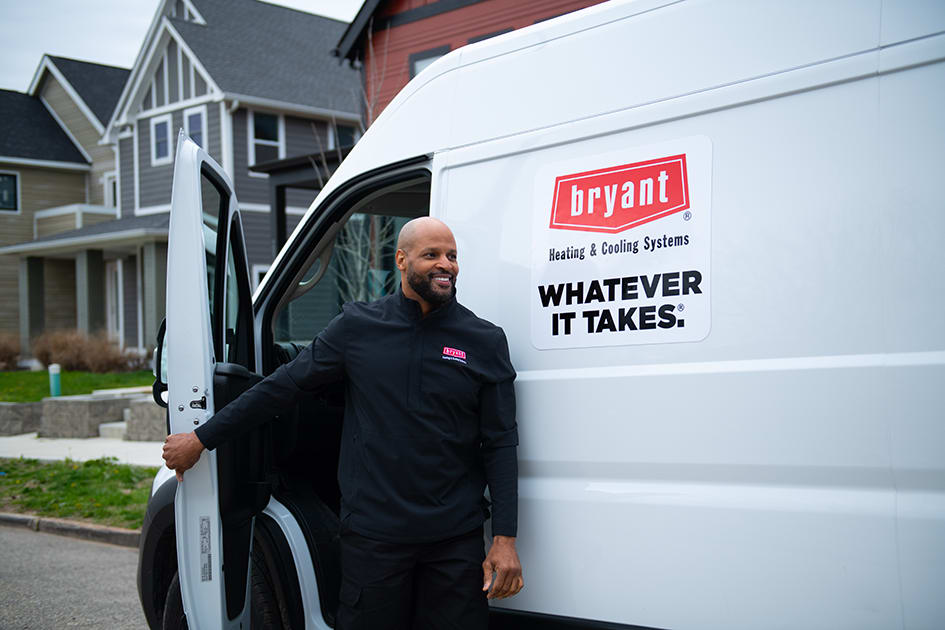Whole-Home Humidifier Repair: Troubleshooting and Solutions
Quick Answer: If your Bryant whole-home humidifier isn't working, first ensure the water supply valve is open, the humidistat is set correctly (typically 35-45%), and the water panel (evaporator pad) is clean. Common failures include clogged water panels, stuck solenoid valves, or blocked drain lines. For electrical issues or persistent leaks, professional repair is recommended to protect your HVAC system.
If your Bryant whole-home humidifier isn’t keeping up with your comfort needs, you might notice dry air, static electricity, or even cracked wood furniture. Use this guide for practical humidifier repair tips, step-by-step troubleshooting, and clear solutions tailored to Bryant systems. type of whole house humidifier

Common Whole-Home Humidifier Problems
- Low or No Humidity: Often caused by a clogged water panel, a closed water supply valve, or a faulty humidistat sending incorrect signals.
- Water Leaks: Usually result from a blocked drain line, high water pressure, or a cracked distribution tray due to mineral scale buildup.
- Strange Noises: In fan-powered units, buzzing or rattling may indicate a worn fan motor or debris in the housing. A humming sound without water flow often points to a stuck solenoid valve.
- Constant Running: A miscalibrated humidistat or a welded contact on the control board can cause the unit to run continuously, wasting water and energy.

DIY Humidifier Troubleshooting Steps
Before scheduling professional service, you can safely perform these checks to see if a simple fix will restore your system's efficiency.
- Check the Humidistat: Ensure your humidity set point is appropriate for the current outdoor temperature (usually between 30-50%).
- Verify Water Flow: Locate the saddle valve or water supply line and ensure it is fully open.
- Inspect the Water Panel: Turn off the power and check the evaporator pad. If it is crusted with white mineral scale, it is restricting airflow and moisture output.
- Check the Damper (Bypass Models): If you have a bypass humidifier, ensure the damper is in the "Open" or "Winter" position to allow airflow through the unit.
Basic Whole-Home Humidifier Maintenance
Regular humidifier maintenance is the most effective way to avoid costly humidifier troubleshooting down the road. Routine care limits mineral buildup and prevents microbial growth, ensuring your air remains healthy and comfortable.
How to Clean and Maintain Your Unit
- Power Down: Turn off power to both the humidifier and your HVAC system.
- Remove the Water Panel: Access the unit and slide out the water panel. If it is worn, clogged, or heavily scaled, replace it with a genuine Bryant water panel.
- Clean Internal Parts: Wipe down the distribution tray and housing with a soft cloth. Avoid harsh chemicals. Rinse away loose mineral deposits with lukewarm water.
- Clear the Drain: Check the drain line for any blockages to prevent water backup and leaks.
- Restart: Reassemble the unit, restore power, and set your humidistat to the desired level.
Pro Tip: Replace your water panel at the start of every heating season. If you have hard water, you may need to replace it mid-season to maintain optimal performance.
What to expect From Professional Whole-House Humidifier Repair
- Test Components: Verify the operation of the solenoid valve, humidistat, and sensing relays.
- Inspect Electrical: Check for loose connections, blown fuses, or inactive control boards that interrupt operation.
- Clear Blockages: Professionally remove stubborn mineral scale from the distribution tray and drain lines.
- Calibrate Sensors: Ensure your humidistat reads humidity levels accurately for precise control.
Why Professional Help Matters:
Connect With A Bryant Dealer For Humidifier Repair
Humidifier Repair FAQs
- Explore Bryant humidifiers
- Discover the best humidifier for your home
- Learn what does a humidifier do?
- Find out what humidity should my house be at?
- Understand humidifier maintenance best practices
- Learn the ins and outs of humidifier installation
- Discover humidifier benefits
- Explore similarities and differences between a humidifier vs dehumidifier
- Understand the difference between an air purifier and humidifier
- Discover whole house humidifier types
- Explore the factors of whole house humidifier cost
- Understand the best humidity level for sleeping


